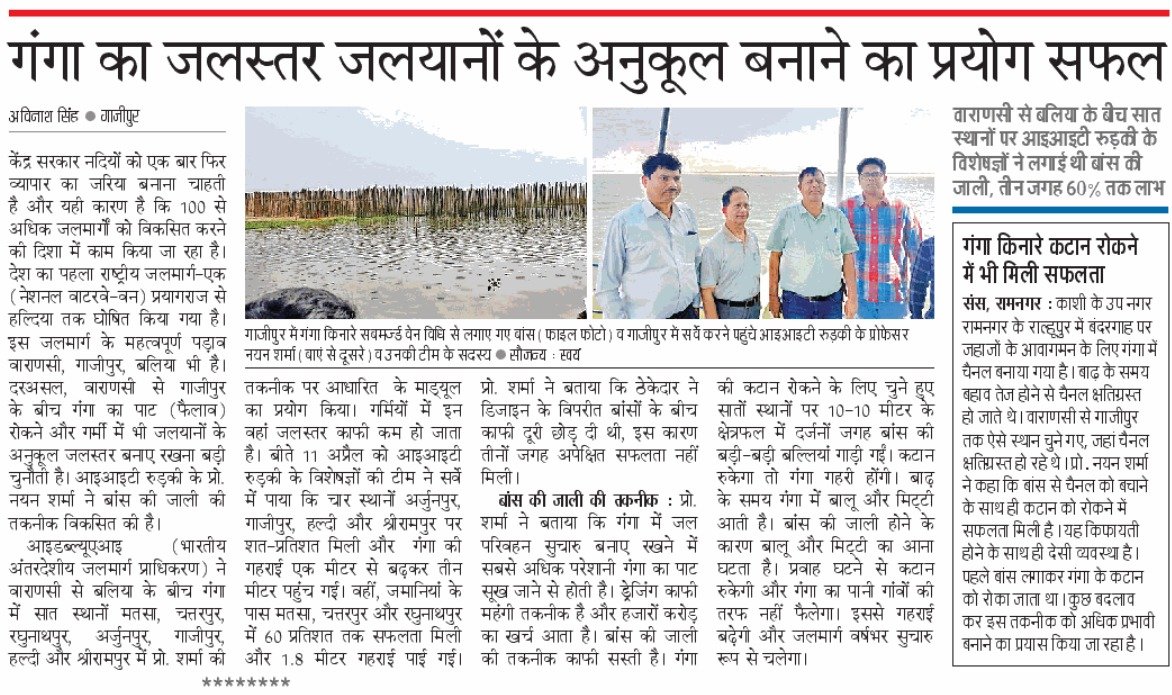


Introduction
In an effort to revive rivers as a means of trade, the central government of India has undertaken the development of over 100 waterways. The first National Waterway-One (National Waterway - One) has been declared from Prayagraj to Haldia, with important stops including Varanasi, Ghazipur, and Ballia. However, maintaining a favourable water level for vessels in the Ganga River, especially during summer when the water level is low, poses a significant challenge. To address this issue, Professor Nayan Sharma from IIT Roorkee has developed a technique called submerged Vanes, which involves using bamboo netting. The successful implementation of this technique by the Inland Waterways Authority of India (IWAI) has shown promising results in improving the water depth in the Ganga River.
The Technique of Submerged Vanes
The technique of submerged Vanes, developed by Professor Nayan Sharma, involves the strategic placement of bamboo poles to control the water flow and prevent erosion. IWAI has implemented this technique at seven locations in the Ganga River, specifically between Varanasi to Ballia. These locations include Mathara, Chatarpur, Raghunathpur, Arjunpur, Ghazipur, Haldi, and Shrirampur. The primary objective is to increase the water depth and maintain a smooth waterway throughout the year, even during the low-water summer season.
Successful Results and Impact
A team of experts from IIT Roorkee conducted a survey on April 11 and found that the technique of submerged Vanes yielded positive results at several locations. Notably, at Arjunpur, Ghazipur, Haldi, and Shrirampur, there was a 100 percent success rate in terms of water depth, with the depth increasing from one meter to three meters. At Matsa, Chattarpur, and Raghunathpur near Jamanian, a 60 percent success rate was achieved, resulting in a water depth of 1.8 meters. The success at these locations demonstrates the effectiveness of the technique in maintaining a favourable water level for ships.
Cost-Effectiveness and Environmental Benefits
According to Professor Sharma, one of the key advantages of the submerged Vanes technique is its cost-effectiveness compared to traditional dredging methods. Dredging, which involves removing sediment from the riverbed, is an expensive technique that can cost thousands of crores. In contrast, the technology of submerged Vanes utilizes large bamboo poles driven into the riverbed within a 10-meter radius at the designated locations. This approach not only reduces costs but also minimizes the environmental impact caused by extensive dredging activities.
Addressing the Challenge of Drying Ganges and Preventing Erosion
Professor Sharma emphasizes that the drying up of the Ganges is a major obstacle to maintaining smooth water transport in the river. By implementing submerged Vanes, the flow of the river can be controlled, reducing erosion and preventing the spread of water towards surrounding villages. This, in turn, increases the depth of the Ganga River and ensures a consistent water level for ships throughout the year.
Conclusion
The successful experiment of using submerged Vanes to make the water level of the Ganga River favourable for ships marks a significant achievement in India's efforts to revitalize its waterways. The implementation of this technique by IWAI has shown promising results in increasing water depth and ensuring a smooth waterway for trade and transportation.
Frequently Asked Questions:
What is the submerged Vanes technique?
The submerged Vanes technique involves strategically placing bamboo poles in the river to control water flow and prevent erosion, thereby increasing the water depth and maintaining a smooth waterway.
Who developed the submerged Vanes technique?
The technique was developed by Professor Nayan Sharma from IIT Roorkee.
How many locations have implemented the submerged Vanes technique?
The Inland Waterways Authority of India (IWAI) has implemented this technique at seven locations in the Ganga River, specifically between Varanasi to Ballia.
What are the benefits of using submerged Vanes?
Using submerged Vanes is cost-effective compared to traditional dredging methods, reduces environmental impact, and helps maintain a favorable water level for ships.
What were the results of the experiment?
The experiment showed promising results, with a 100 percent success rate in increasing water depth at locations such as Arjunpur, Ghazipur, Haldi, and Shrirampur. At other locations like Mathara, Chattarpur, and Raghunathpur, a 60 percent success rate was achieved.
How does the submerged Vanes technique address the challenge of drying Ganges and erosion?
By controlling the flow of the river and preventing erosion, the submerged Vanes technique helps maintain a consistent water level in the Ganga River, preventing drying up and ensuring a smooth waterway for transportation.
How does the submerged Vanes technique compare to traditional dredging methods?
The submerged Vanes technique is more cost-effective and has a lesser environmental impact compared to traditional dredging, which involves removing sediment from the riverbed.
What is the significance of the experiment for India's waterways?
The successful implementation of the submerged Vanes technique signifies a significant achievement in India's efforts to revitalize its waterways, particularly the Ganga River, for trade and transportation.
Keywords –
#Submerged Vanes for Ganga River
#Ship Navigation in Ganga River
#Water Flow Control Techniques
#Erosion Prevention in Ganga River
#Water Depth Management Solutions
#IIT Roorkee Ganga River Project
#IWAI Ship Navigation Initiatives
#Cost-Effective Water Level Management
#Environmental Impact of Submerged Vanes
#Dredging Alternatives for Ganga River
#Sediment Removal Techniques in Ganga River
#Consistent Water Level Strategies
#Revitalization of Ganga River for Trade
#Transportation Solutions for Ganga River
#Varanasi to Ballia Waterway Project
#Sustainable Water Level Management
#Enhancing Ganga River Navigation
#Ganga River Restoration Techniques
#Optimal Water Level for Ganga River
#Economic Benefits of Submerged Vanes in Ganga River